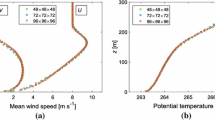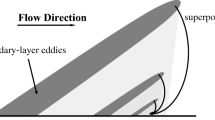Abstract
Based on a mesoscale RANS model of turbulence, the behavior of turbulent eddy mixing parameters is found to agree with the latest data of laboratory and atmospheric measurements. Some problems of the description of turbulent eddy mixing in the atmospheric boundary layer are studied. When the flow transforms to an extremely stable state, in particular, it is found the flux Richardson number Ri f can change nonmonotonically: it increases with increasing gradient Richardson number Rig until the state of saturation is reached at Ri g ≃ 1 and then decreases. The behavior of the coefficients of eddy diffusion of momentum and heat agrees with the concept of momentum (but not heat) transfer by internal waves propagating in an extremely stable atmospheric boundary layer.
Similar content being viewed by others
References
P. Monti, H. J. S. Fernando, M. Princevac, et al., “Observations of flow and turbulence in the nocturnal boundary layer over a slope,” J. Atmospher. Sci., 59, 2513–2534 (2002).
E. J. Strang and H. J. S. Fernando, “Vertical mixing and transport through a stratified shear layer,” J. Phys. Oceanogr., 31, 2006–2048 (2001).
A. F. Kurbatskiy and L. I. Kurbatskaya, “On the turbulent Prandtl number in a stable stratified atmospheric boundary layer,” Izv. Ross. Akad. Nauk, Fiz. Otmos. Okeana, 46, No. 2, 187–196 (2010).
E. R. Pardyjak, P. Monti, and H. J. S. Fernando, “Flux Richardson number measurements in stable atmospheric shear flows,” J. Fluid Mech., 459, 307–316 (2002).
A. S. Monin and A. M. Yaglom, Statistische Hydromechanik. 1. Mechanik der Turbulenz, Verlag-Nauka, Moskau (1965).
A. F. Kurbatskiy and L. I. Kurbatskaya, “\(E - \varepsilon - \overline {\theta '^2 }\) turbulence closure model for an atmospheric boundary layer including the urban canopy,” Meteorol. Atmospher. Phys., 104, 63–81 (2009).
A. F. Kurbatskiy and L. I. Kurbatskaya, “Modeling of a stable boundary layer with a low-level jet,” J. Appl. Mech. Tech. Phys., 51, No. 5, 655–662 (2010).
P. J. Roache, Computational Fluid Mechanics, Hermosa, Albuquerque (1976).
G. L. Mellor and T. Yamada, “Development of a turbulent closure model for geophysical problems,” Rev. Geophys. Space Phys., 20, 851–875 (1982).
M. Nakanishi, “Improvement of the Mellor-Yamada turbulence closure model based on large-eddy simulation data,” Boundary-Layer Meteorol., 99, 349–378 (2001).
T. Yamada, “The critical Richardson number and the ratio of the eddy transport coefficients obtained from a turbulence closure model,” J. Atmospher. Sci., 32, 926–933 (1975).
A. Mahalov, B. Nicolaenko, K. L. Tse, and B. Joseph, “Eddy mixing in jet-stream turbulence under stronger stratification,” Geophys. Res. Lett., 31, L23111 (2004).
Author information
Authors and Affiliations
Corresponding author
Additional information
__________
Translated from Prikladnaya Mekhanika i Tekhnicheskaya Fizika, Vol. 52, No. 6, pp. 43–49, November–December, 2011.
Rights and permissions
About this article
Cite this article
Kurbatskiy, A.F., Kurbatskaya, L.I. Efficiency of eddy mixing in a stable stratified atmospheric boundary layer. J Appl Mech Tech Phy 52, 883–888 (2011). https://doi.org/10.1134/S0021894411060058
Received:
Published:
Issue Date:
DOI: https://doi.org/10.1134/S0021894411060058




